Iris Borers
Japanese Beetles
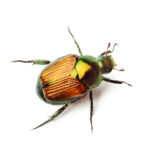
June Beetles
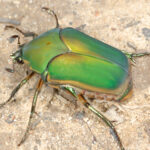 These are those big (up to three centimeters) brown beetles which smack into your screen door during hot summer nights. Some people may consider this annoying and will, therefore, for that reason, mark these critters as pests. Their adult forms are, indeed pests as they do chew of the leaves of many plants. It is, however, their large, white C-shaped larvae or grubs which are really the most destructive pests. The grubs chew on your lawn’s roots and can cause patches of lawn to die. Moreover, they may also feed on the roots of other plants including corn, potatoes, strawberries and other vegetables and fruits. Their presence can also lead a mole invasion which, in its own right, can devastate a lawn or garden. (The best way to get rid of moles is to destroy their source of food: the grubs.) As is the case with Japanese beetles you’re better off targeting the grubs, in which case Parasitic Nematodes, the Heterorhabditis bacteriophora species, can control these pests. Additionally, covering prize plants with row covering material can keep migrating adults at bay.
These are those big (up to three centimeters) brown beetles which smack into your screen door during hot summer nights. Some people may consider this annoying and will, therefore, for that reason, mark these critters as pests. Their adult forms are, indeed pests as they do chew of the leaves of many plants. It is, however, their large, white C-shaped larvae or grubs which are really the most destructive pests. The grubs chew on your lawn’s roots and can cause patches of lawn to die. Moreover, they may also feed on the roots of other plants including corn, potatoes, strawberries and other vegetables and fruits. Their presence can also lead a mole invasion which, in its own right, can devastate a lawn or garden. (The best way to get rid of moles is to destroy their source of food: the grubs.) As is the case with Japanese beetles you’re better off targeting the grubs, in which case Parasitic Nematodes, the Heterorhabditis bacteriophora species, can control these pests. Additionally, covering prize plants with row covering material can keep migrating adults at bay.Lace Bugs
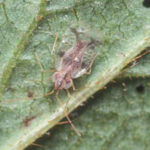 Very unusual in appearance with their white, lacy wings and squared, hourglass shape and being about five to seven millimeters long, lace bugs are known pests of a wide variety of trees, shrubs and other plants, including vegetables and flowers. They suck the sap from leaf undersides and can cause a great deal of damage in the form of speckling and chlorotic leaves. Based on feedback, at least in outdoor settings, the insidious flower bug, Orius insidiosus, is quite capable of controlling these pests. The flower bug, it seems, probes the lace bug’s egg and nymphal stages with it proboscis or sharpened, straw-like mouthpart. Regarding other pest control products? Well, there’s not much available. Fortunately the people who’ve reported good news about insidious flower bugs being not just for thrips anymore have been quite convincing. Our suggestion: try it.
Very unusual in appearance with their white, lacy wings and squared, hourglass shape and being about five to seven millimeters long, lace bugs are known pests of a wide variety of trees, shrubs and other plants, including vegetables and flowers. They suck the sap from leaf undersides and can cause a great deal of damage in the form of speckling and chlorotic leaves. Based on feedback, at least in outdoor settings, the insidious flower bug, Orius insidiosus, is quite capable of controlling these pests. The flower bug, it seems, probes the lace bug’s egg and nymphal stages with it proboscis or sharpened, straw-like mouthpart. Regarding other pest control products? Well, there’s not much available. Fortunately the people who’ve reported good news about insidious flower bugs being not just for thrips anymore have been quite convincing. Our suggestion: try it.Leafhoppers
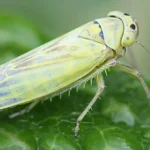 These are interesting insects. They are somewhat triangular in shape and range in size from four millimeters to about one centimeter. Some species bear incredible coloration: light green, purple and blue stripes, and some red. Leafhoppers can also be incredible pests if their numbers are large-which is often the case in gardens and other outdoor growing areas. Leafhoppers suck plant sap which, in its own right, is bad enough. Additionally, though, they also secrete a toxin as they feed, which, when coupled with their feeding can cause serious damage. Leaf deformities, stunted tip growth and scorching are all symptoms of these activities. Now there are some products capable of controlling leafhoppers, but few sprays actually include this pest on their label. Insecticidal soap is one product which does include this pest on the label. So, for commercial growers, anyway, this may present a logistics problem as in many states the label rules. Biocontrol agents commercially available to target these pests are also few and far between. One predator, the spined soldier bug, Podisus maculiventris, may provide one solution. Spined soldier bugs are commercially available and will not spark legal debate. Moreover, there are attractors available for these predatory bugs, so if cost becomes an issue-which it may as these true bugs are still expensive — you’ll have an option. The only other option that I know of is to exclude these pests by using a row cover fabric.
These are interesting insects. They are somewhat triangular in shape and range in size from four millimeters to about one centimeter. Some species bear incredible coloration: light green, purple and blue stripes, and some red. Leafhoppers can also be incredible pests if their numbers are large-which is often the case in gardens and other outdoor growing areas. Leafhoppers suck plant sap which, in its own right, is bad enough. Additionally, though, they also secrete a toxin as they feed, which, when coupled with their feeding can cause serious damage. Leaf deformities, stunted tip growth and scorching are all symptoms of these activities. Now there are some products capable of controlling leafhoppers, but few sprays actually include this pest on their label. Insecticidal soap is one product which does include this pest on the label. So, for commercial growers, anyway, this may present a logistics problem as in many states the label rules. Biocontrol agents commercially available to target these pests are also few and far between. One predator, the spined soldier bug, Podisus maculiventris, may provide one solution. Spined soldier bugs are commercially available and will not spark legal debate. Moreover, there are attractors available for these predatory bugs, so if cost becomes an issue-which it may as these true bugs are still expensive — you’ll have an option. The only other option that I know of is to exclude these pests by using a row cover fabric.Leafrollers
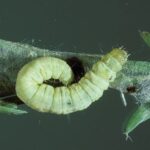
Leafrollers are moths whose eggs hatch into the typically destructive larvae. These two centimeter brass-colored moths lay their eggs on branch tips and leaves. The resulting larvae feed at the point in which they grew from eggs to larva-hood. They’re called leafrollers because, after a month’s time they pupate in a cocoon-like shelter they make themselves. The pre-pupal larvae roll leaves lengthwise by spinning their webbing around them-most of them do, anyway, some species prefer to lie tucked into the bark of trees. In either case, they use the cocoon as an abode over the winter months. Trichogramma spp. parasitic wasps may help control populations of these critters by parasitizing the eggs. This would be done during late spring and early summer. Another egg control technique would involve physically removing the egg masses. The larvae can be dealt with by way of Bacillus thuringiensis (Bt) variety Kurstaki. The leaves and buds would be treated while the larvae or caterpillars are feeding. Another control worth doing is to physically squash the larvae in their leaf-rolled cocoons. Pop! (Just a thought.)
Mexican Bean Beetles
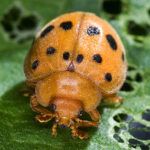 Bad bugs sometimes resemble good bugs. And this is the case with these bean-loving skeletonizing beetles. They look very similar to our friend, the ladybug. Bean beetles are more of an orange color, though, and their spots are smaller and seem sort of in rows running side to side. They are about seven millimeters long as adults and similarly sized as larvae. The larvae are orange and very “spiky” looking. They will feed on most leguminous (legume) crops, and as anyone growing beans will know, they like those best. There is little in the way of sprays and such which can stop these pests, which isn’t toxic (and remember some natural botanical chemicals are indeed toxic). Interestingly, there are two commercially produced biological pest control agents “labeled” for use on Mexican bean beetles. The spined soldier bug, Podisus maculiventris, will feed on the eggs and larvae. A parasitic mini-wasp, Pediobius foveolatus, very effectively parasitizes the larvae. Timing is important for a first generation kill, though, if you want to implement these biocontrols successfully, especially the parasitoids.
Bad bugs sometimes resemble good bugs. And this is the case with these bean-loving skeletonizing beetles. They look very similar to our friend, the ladybug. Bean beetles are more of an orange color, though, and their spots are smaller and seem sort of in rows running side to side. They are about seven millimeters long as adults and similarly sized as larvae. The larvae are orange and very “spiky” looking. They will feed on most leguminous (legume) crops, and as anyone growing beans will know, they like those best. There is little in the way of sprays and such which can stop these pests, which isn’t toxic (and remember some natural botanical chemicals are indeed toxic). Interestingly, there are two commercially produced biological pest control agents “labeled” for use on Mexican bean beetles. The spined soldier bug, Podisus maculiventris, will feed on the eggs and larvae. A parasitic mini-wasp, Pediobius foveolatus, very effectively parasitizes the larvae. Timing is important for a first generation kill, though, if you want to implement these biocontrols successfully, especially the parasitoids.Mosquitoes
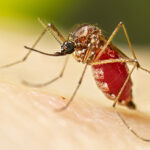 Like fleas, mosquitoes are bloodsuckers and are infamous for the diseases they are known to transmit. Yellow fever, malaria, the “new scourge” West Nile virus (mosquito-borne encephalitis virus), and other problematic diseases. Fortunately, mosquitoes are not yet credited with the spread of HIV or — the bug which leads to AIDS. But what’s next? What pandemic virus lurks in the future? As far as controlling them in an effort to eliminate them is practically impossible without destroying their habitat by building a city or creating a drought-stricken area. And community spraying tends to work, but that’s not a decent choice. You can keep them from biting by using some deet- or citronella-based repellent (in the form of a spray, lotion or even a smoke), which can’t be very good for you either. Or you can cover yourself with netting, but this is an uncomfortable option most would choose to avoid. So what you have to do, if you want to stay somewhat Green, is to compromise yourself by accepting mosquitoes to a certain extent-to a large extent, actually. This doesn’t mean you can’t fight back a little, though. There are three ways to control mosquitoes while keeping your environmental conscientiousness in tact. The first is to encourage their natural enemies, creatures like dragon flies and bats. Dragonflies are encouraged by much of the same things which keep mosquitoes happy. In fact, mosquitoes make dragonflies happy. So does diversity in your plantings. To encourage bats try giving them a home. Commercially available wooden bat houses are a simple and inexpensive way to increase your local bat population. Bats consume many types of nocturnally flying insects: moths, beetles, etc. Many of which are pests. A single bat can consume roughly 300 to 500 insects in a single night. Encourage bats, and you’ll be encouraging natural pest control methods at its finest. You’ll still have mosquitoes, but depending upon the number of bats you host, you’ll have a smaller number. The second way you can cut into their numbers is to attack their larvae. Mosquito larvae suspend themselves on the surface of standing water-supported by the water’s surface tension. An insecticidal bacteria, Bacillus thuringiensis (I) variety israelensis (Bti), in the form of positively buoyant, doughnut-shaped briquettes, aggressively destroy these immature mosquitoes. The larvae consume the bacteria which covers the water’s surface and quickly die as their stomach lining disintegrates-ultimately digesting themselves. Sounds pretty hazardous doesn’t it? To fish, mammals and birds, Bti is completely innocuous. And these briquettes, which can be a somewhat costly option, do a fantastic job. All you have to do is make sure all standing water, including vernal pools (which exist only seasonally or after large rainstorms), old tires and unused, algae-covered kiddie pools get treated and remain so throughout the mosquito season. The third is to employ a mosquito repellent; there’s a garlic-based product which is supposed to work very well.
Like fleas, mosquitoes are bloodsuckers and are infamous for the diseases they are known to transmit. Yellow fever, malaria, the “new scourge” West Nile virus (mosquito-borne encephalitis virus), and other problematic diseases. Fortunately, mosquitoes are not yet credited with the spread of HIV or — the bug which leads to AIDS. But what’s next? What pandemic virus lurks in the future? As far as controlling them in an effort to eliminate them is practically impossible without destroying their habitat by building a city or creating a drought-stricken area. And community spraying tends to work, but that’s not a decent choice. You can keep them from biting by using some deet- or citronella-based repellent (in the form of a spray, lotion or even a smoke), which can’t be very good for you either. Or you can cover yourself with netting, but this is an uncomfortable option most would choose to avoid. So what you have to do, if you want to stay somewhat Green, is to compromise yourself by accepting mosquitoes to a certain extent-to a large extent, actually. This doesn’t mean you can’t fight back a little, though. There are three ways to control mosquitoes while keeping your environmental conscientiousness in tact. The first is to encourage their natural enemies, creatures like dragon flies and bats. Dragonflies are encouraged by much of the same things which keep mosquitoes happy. In fact, mosquitoes make dragonflies happy. So does diversity in your plantings. To encourage bats try giving them a home. Commercially available wooden bat houses are a simple and inexpensive way to increase your local bat population. Bats consume many types of nocturnally flying insects: moths, beetles, etc. Many of which are pests. A single bat can consume roughly 300 to 500 insects in a single night. Encourage bats, and you’ll be encouraging natural pest control methods at its finest. You’ll still have mosquitoes, but depending upon the number of bats you host, you’ll have a smaller number. The second way you can cut into their numbers is to attack their larvae. Mosquito larvae suspend themselves on the surface of standing water-supported by the water’s surface tension. An insecticidal bacteria, Bacillus thuringiensis (I) variety israelensis (Bti), in the form of positively buoyant, doughnut-shaped briquettes, aggressively destroy these immature mosquitoes. The larvae consume the bacteria which covers the water’s surface and quickly die as their stomach lining disintegrates-ultimately digesting themselves. Sounds pretty hazardous doesn’t it? To fish, mammals and birds, Bti is completely innocuous. And these briquettes, which can be a somewhat costly option, do a fantastic job. All you have to do is make sure all standing water, including vernal pools (which exist only seasonally or after large rainstorms), old tires and unused, algae-covered kiddie pools get treated and remain so throughout the mosquito season. The third is to employ a mosquito repellent; there’s a garlic-based product which is supposed to work very well.